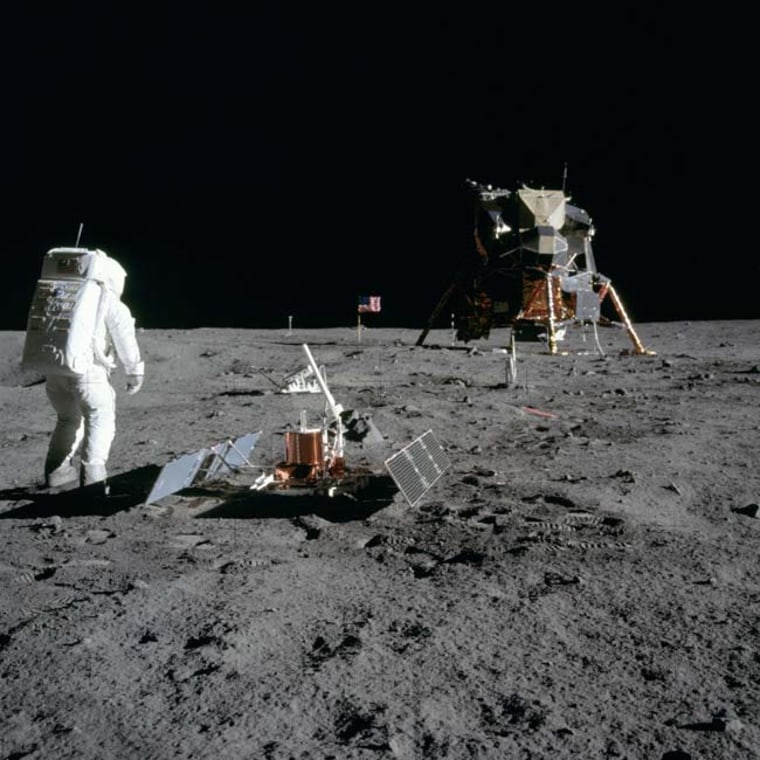The first astronauts to walk on the moon in the 1960s and 1970s were inundated by sticky lunar dust that clung to their spacesuits whenever they ventured outside. Now, four decades later, a self-funded study by an Australian physicist has found a link between the dust's stickiness and the angle of the sun at the time of each moonwalk.
The new research, which drew on the personal files and paper charts of physicist Brian O'Brien of Perth, suggests that future lunar astronauts may have greater problems with dust adhesion in the middle half of the day than NASA's Apollo missions faced in the early morning.
"Dust is the number one environmental hazard on the moon, yet its movements and adhesive properties are little understood," said O'Brien, who was the principal investigator for the Dust Detector Experiment on several Apollo lunar landing missions between 1969 and 1970. His new research will be detailed in the Geophysical Research Letters.
Sticky science
The new study points out that the electrostatic adhesive forces of dust decreases as sunlight on the moon decreases. Furthermore, O'Brien believes that some sort of lunar shack for on-duty moonwalkers may be mandatory to provide for a sunlight-thwarting, dust-free working environment.
"It follows that on future lunar expeditions, powerful electrostatic adhesion of lunar dust during the middle half of each lunar day could cause greater dust problems than experienced by Apollo astronauts," he relates.
This model by O'Brien infers that Apollo astronaut problems from clinging dust, at solar elevations much less than 45 degrees, may have been driven by other forces. Mechanical bonding properties intrinsic to lunar dust, he suggests, could explain partial success by moonwalkers in shedding gear of dust with "moon brushes."
Detecting moon dust
Invented by O'Brien, the matchbox-sizeddetectors for the DDE study were planted on the moon during the Apollo 11, 12, 14 and 15missions. O'Brien carried out that work while serving as a professor of space science at Rice University in Houston, Texas, from 1963 to 1968.
O'Brien was one of seven scientists chosen by NASA from 90 applicants to provide sophisticated instruments in remote scientific stations deployed by Apollo astronauts. While another of his projects, the Charged Particle Lunar Environment Experiment, was lost on Apollo 13, it was deployed during the Apollo 14 moon landing mission.
It turns out that NASA had misplaced its computer tapes of the experimental data but O'Brien preserved his copies.
"I started to revisit the personal Dust Detector Experiment (DDE) data in 2007 after learning in late 2006 that the sole source of data was with me," he told SPACE.com.
Spray of debris
In another finding by O'Brien, Apollo 11's DDE made the first measurements suggesting that rocket exhaust caused significant contamination of deployed equipment.
Apollo 11's dust detectors, O'Brien said, showed the impact of rocket exhaust spit out from the departure of the Eagle lunar module's ascent stage. This stage was the home, hotel and vehicle back into lunar orbit for Neil Armstrong and Buzz Aldrin, and a key step in returning them to home planet Earth.
Eagle's liftoff from Tranquility Base caused quite a stir, environmentally speaking.
There was significant contamination of astronaut-deployed hardware by kicked-up lunar material. So much so that the spray of debris caused by the departing rocket motor led to the overheating and early failure of Apollo 11's Passive Seismic Experiment - the first major scientific experiment put on the moon by human hands.
A lesson learned here is where best to place equipment given future landings and takeoffs of moon vehicles. For Apollo 11's DDE, it was deployed roughly 55 feet (17 meters) away from the Eagle lander.
"Such damage was a foreseen possibility... accepted on this first mission in interests of astronaut safety. These benchmark measurements on the moon appear unused and unreferenced in theoretical modeling of effects of rocket exhausts," O'Brien explains.
Considering NASA's plan to return humans to the lunar surface for longer stints, there's another lesson underscored by O'Brien's work. That is, the need to better preserve, dust off, and revisit Apollo data.
